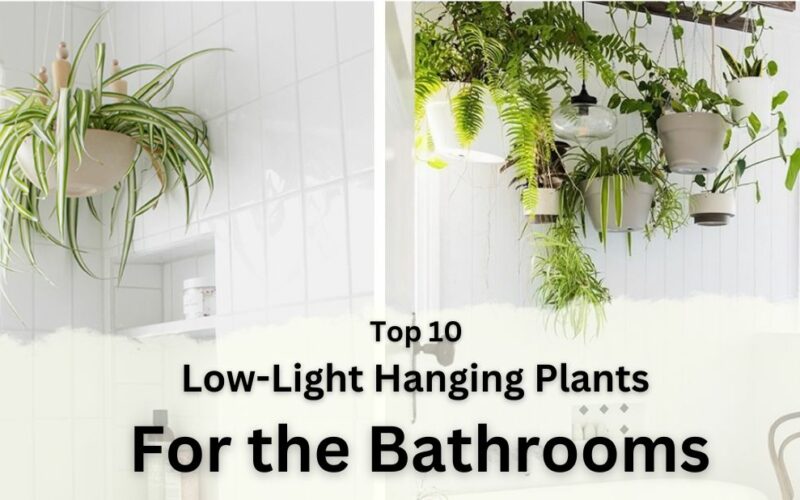If you a fan of Spa-like bathrooms or interested in adding a natural character to them, here you can find the best Low-light hanging plants for the bathrooms with their images, names, and pro tips for caring for them.
Although there are several low-light high-humidity plants for bathrooms, hanging plants are more popular. You can hang them from different parts without concern about spaces. Due to most of the bathrooms being damp and dim, it’s critical to choose hanging indoor plants that can thrive in low-light conditions.
In this post, I provided you with 10 of the best, but before diving into the world of Low-light hanging plants for the bathrooms, let me tell you about the benefits and cons of using them.
Benefits of Adding Plants in Your Bathroom

- Bathroom plants can Improve air quality by removing toxins and pollutants, such as formaldehyde and benzene. This pollution is found in common bathroom products like cleaning agents, air fresheners, and personal care items.
- They also can Increase oxygen levels in your bathrooms by releasing oxygen during photosynthesis.
- The low-light hanging plants for the bathrooms can Reduce humidity by absorbing excess moisture. It can help prevent mold and mildew growth in enclosed places like bathrooms.
- If you are a fan of a Spa-like atmosphere, plants can add a natural and calming aesthetic to your bathroom.
- Various studies have shown that plants have an impact on reducing stress levels and improving mood. If you use your bathroom as a space for relaxation and self-care, adding plants there can help you with this issue.
Can I Put Any Indoor Hanging Plants in my Bathroom?
Come on to tell you pro tips about choosing the best houseplant for bathrooms:
- Please note that the heat and humidity of the bathrooms aren’t ideal for all plants, hence you must choose low-ight high humidity plants that will positively flourish in those conditions.
- In addition, light is a basic requirement for almost all plants, but unfortunately, most bathrooms are enclosed dim spaces with no natural light. So, you must think about certain cultivars that can tolerate low-light conditions. Low-light hanging plants for the bathrooms can be ideal in this situation. You can also get help with fluorescent lighting.
What Are the Problems of Adding Hanging Plants to My Bathroom Decor?
- In near-constant moisture, the risk of some diseases will increase. So, you must watch out for signs of root rot or powdery mildew.
- In addition, the Fungus gnats may also become a problem. I recommend dealing with them by using sticky traps and adding the beneficial nematodes for Fungus gnats.
Now come on to find the best hanging plants that can thrive in dark and humid bathrooms.
The Best Low-Light Hanging Plants for the Bathrooms
Asparagus Ferns: Bathroom Plants That Absorb Moisture

Scientific name: Asparagus densiflorus
Other common names: Lace Fern, Plumosa Fern
This fern is one of the best Low-light hanging plants for the bathrooms. It has delicate, needle-like leaves that grow in a feathery pattern. It produces small white flowers and red berries in the fall.
Asparagus fern can help purify indoor air and is known to be a natural air freshener. Hence you can use it as a low-light indoor plant for bedrooms too.
Caring Points for Asparagus Fern:
- Place in bright, indirect light.
- Keep the soil consistently moist, but avoid overwatering.
- Ferns are low-light high-humidity plants. Mist the leaves regularly to provide humidity.
- Feed with a balanced houseplant fertilizer every two weeks during the growing season.
- Pests: Spider mites, mealybugs, and scale insects can infest asparagus ferns.
- Diseases: Asparagus ferns are generally resistant to diseases, but overwatering can lead to root rot.
Bird’s Nest Fern

Scientific name: Asplenium nidus
Other common names: Nest Fern, Crow’s Nest Fern
The fronds of this fern form a rosette shape that resembles a bird’s nest. It has wavy, dark green fronds that can grow up to 2 feet long. Hence, They are also large low-light houseplants that are safe for cats and are ideal for adding to your living room.
Bird’s nest fern is great for improving indoor air quality as it can filter out toxins such as formaldehyde and xylene. They are also bathroom plants that absorb moisture.
Caring Points for Bird’s Nest Fern:
- Place in medium to bright indirect light.
- Keep the soil evenly moist, but not soggy.
- Mist the leaves regularly or place them on a tray with water to increase humidity.
- Avoid cold drafts and temperature extremes.
- Pests: Mealybugs and scale insects can occasionally be a problem.
- Diseases: Bird’s nest ferns are generally resistant to diseases, but overwatering and lack of proper airflow can lead to fungal issues.
Bromeliad

Scientific name: The Bromeliaceae family includes many genera and species. Some common ones include Neoregalia spp. And Guzmania spp.
Other common names: Pineapple Plant (for some species), Air Plant (for some epiphytic species
These plants come in a variety of shapes, sizes, and colors, but most have long, narrow leaves that grow in a rosette pattern. They are known for their bright, colorful flowers that bloom from the center of the plant. you can consider them colorful low-light houseplants that can add energy and color to your dim lifeless rooms.
Bromeliads are great for improving indoor air quality and can also help regulate humidity levels in the home
Caring Points for Bromeliad:
- Place in bright, indirect light.
- Water the central cup of the plant regularly to keep it filled with water.
- Allow the soil to dry slightly between waterings.
- Maintain moderate humidity levels around the plant.
- Pests: Mealybugs and scale insects can infest bromeliads.
- Diseases: Overwatering can cause root rot, and improper drainage can lead to fungal infections.
Devil’s Ivy

Scientific name: Epipremnum aureum
Other common names: Money Plant, Golden Pothos
This trailing vine has heart-shaped leaves that vary in color from light green to yellow and white. Devil’s ivy is known for its ease of care and air-purifying properties. It can help remove toxins such as formaldehyde and benzene from indoor air.
Caring Points for Devil’s Ivy:
- Can tolerate a wide range of light conditions, from low to bright indirect light.
- Water when the top inch of soil feels dry.
- Allow excess water to drain from the pot to prevent root rot.
- Trim and prune as needed to maintain its desired shape.
- Pests: Mealybugs, spider mites, and aphids can infest pothos.
- Diseases: Overwatering can cause root rot, and low humidity levels may lead to browning leaf tips.
Spider Plant

Scientific name: Chlorophytum comosum
Other common names: Airplane Plant
This plant has long, thin leaves that grow in a rosette pattern. It produces small white flowers that develop into baby spider plants. Spider plants are known for their air-purifying properties and ability to remove toxins such as formaldehyde and xylene from the air. You can also use them as bathroom plants that absorb moisture.
Caring Points for Spider Plant:
- Can tolerate various light conditions, but prefers bright, indirect light.
- Water when the top inch of soil is dry.
- Maintain moderate humidity levels.
- Remove any yellow or brown leaves regularly.
- Pests: Spider mites can be a problem for spider plants.
- Diseases: Spider plants are generally resistant to diseases but can develop root rot if overwatered.
String Of Turtles: Small Bathroom Plants No Light

Scientific name: Peperomia prostrata
Other common names: Turtle Vine
This trailing plant has small, round leaves that resemble turtle shells. It’s a low-maintenance houseplant that can tolerate low-light conditions and is great for adding texture and interest to indoor spaces.
Caring Points for String of Turtles:
- Place in bright, indirect light, or partial shade.
- Allow the soil to dry out between waterings.
- Avoid overwatering to prevent root rot.
- Provide moderate to high humidity levels.
- Pests: Mealybugs and spider mites can infest peperomia.
- Diseases: Overwatering and poor air circulation can lead to fungal issues.
Staghorn Fern

Scientific name: Platycerium spp. (various species)
Other common names: Elkhorn Fern
This fern has fronds that grow in a unique, antler-like shape. It’s typically mounted on a board or hung from a basket or pot. Staghorn ferns are great for improving indoor air quality and adding a decorative touch to any room.
Caring Points for Staghorn Fern:
- Place in bright, indirect light. Although it can tolerate low-light places.
- Mist the leaves regularly to provide humidity.
- Water by soaking the plant in water for a few minutes, then allowing it to drain.
- Mount or hang the fern to allow proper air circulation.
- Pests: Mealybugs and scale insects can occasionally infest staghorn ferns.
- Diseases: Overwatering and lack of proper air circulation can lead to fungal issues.
Boston Fern

Scientific name: Nephrolepis exaltata
Other common names: Sword Fern
These ferns are bathroom plants that absorb moisture. They have long, graceful fronds that can grow up to 3 feet long. They are known for their air-purifying properties and ability to remove toxins such as formaldehyde and xylene from indoor air.
Caring Points for Boston Fern:
- Place in bright, indirect light, or partial shade.
- Keep the soil consistently moist, but avoid waterlogging.
- Mist the leaves regularly or place them on a tray with water to increase humidity.
- Fertilize with a balanced houseplant fertilizer every two weeks during the growing season.
- Pests: Mealybugs, scale insects, and spider mites can infest Boston ferns.
- Diseases: Overwatering and lack of proper air circulation can lead to fungal issues.
Phalaenopsis Orchids

Scientific name: Phalaenopsis spp.
Other common names: Moth Orchids, Phals
These orchids have large, showy flowers that come in various colors. They are great for adding a pop of color to indoor spaces and can help improve indoor air quality.
Caring Points for Phalaenopsis Orchids:
- Place in bright, indirect light. However, this plant can thrive in dim rooms too.
- Water when the roots appear silvery or dry.
- Allow the potting medium to dry out slightly between waterings.
- Fertilize with a balanced orchid fertilizer according to package instructions.
- Pests: Mealybugs, scale insects, and aphids can infest orchids.
- Diseases: Overwatering, poor air circulation, and fungal infections can occur if the orchid’s growing conditions are not ideal.
African Violet

Scientific name: Saintpaulia spp.
Other common names: Saintpaulia, AVs (abbreviation)
This plant has velvety leaves and produces colorful flowers in shades of purple, pink, and white. You can assume them as “small bathroom plants with no light” too. African violets are known for their air-purifying properties and can help remove toxins such as benzene and formaldehyde from indoor air. They’re also great for adding color and texture to indoor spaces.
Caring Points for African Violet:
- Place in bright, indirect light but it can also thrive in low-light conditions.
- Water the soil from below or use a watering can to avoid getting water on the leaves.
- Allow the soil to dry slightly between waterings.
- Fertilize with a balanced African violet fertilizer every two to four weeks.
- Pests: Aphids, mealybugs, and spider mites can infest African violets.
- Diseases: Overwatering, poor air circulation, and powdery mildew can be an issue if conditions are unfavorable.
|
I love Golden Pothos and Strongly recommend having them because they are low-light hanging plants that can thrive in water and high-humidity conditions. Indeed, Pothos are bathroom plants that absorb moisture. In addition, they are low-maintenance indoor plants that can purify the air too. Thanks to them. 🙂 |
Conclusion
I tried to provide you with the best low-light hanging plants for the bathrooms. I showed you their images and told you their benefits and pro tips for caring for them. know you can make your favorite list and choose the best for your bathroom.
Have you ever placed plants in your bathroom? Some people think putting plants in the bathroom will increase mold and bugs there. Do you agree with them? I usually recommend “hanging plants” that can thrive in water instead of soil such as Pothos. Please share your ideas and experiences with our readers below this page.

Elahe Rabiei
Hi, I’m Elaheh. My Academic major is plant protection, and houseplants are my expertise. As a houseplant lover, my house is full of indoor plants and it is my passion to take care of them. Hence, I’m here to share my knowledge and experience about growing healthy houseplants. I am also a plant protection advisor, so feel free to ask me any questions you may have.


 💡 Golden Recommendation
💡 Golden Recommendation
Wonderful. Thank you for putting this together!